The large bales of hay you see in the picture below are cow cocoons.
In the fall, cows are put inside of these for the winter.
Throughout the winter, the cow grazes on the hay, and by spring has eaten it's way out.
This process keeps the cows safe over the winter, and prevents them from freezing their utters off.
One cow per cocoon is generally the rule, however in cases where there are large cocoons and small cows,
then two may be put into one cocoon.
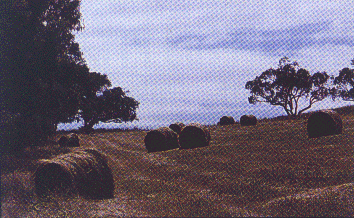
We were allowed to take this picture of the cocoons in the field.
Cocoons are left out there for a few weeks to absorb some heat for the cows.
The cows are not in the cocoons during this phase.

Many cows died during the
development of cow cocoons.
|
Cow cocoons were first used in Canada around the turn of the century. These first cocoons didn't have enough hay around the cows, and many cows died during the cold winter months. Not one to give up, a plucky farmer named Jim tried again, this time with 2 tons of hay and 2 cows. He wrapped the cows up in the hay, tied it all up and left it for the winter.
In the spring, he noticed that the cows had not yet eaten their way out and decided to cut open the cocoons. Much to his dismay, he had discovered that you can't tie the cows up before you put them in the cocoons. |
Cocoons were scoffed at after this and the practice quickly became taboo. It was rumored that those who made cocoons were actually demons from hell. Many farmers were stuffed into cocoons and lit on fire. Cocoon making was then outlawed until the 1950's. It had been believed that cocoon making had stopped during those dark days, however, evidence of cocoons have been recently discovered from this era.
This evidence is usually found in the backs of large farms who have been around since the turn of the century. Rotting hay and sketches of the cocoons have been found on barn walls, evidence that some farmers still practiced cocooning.
Diaries of farmers were found with detailed instructions on how to build the cocoons, as well as the rituals performed during the building of the cocoons. It seemed that cocooning had become a group activity. These groups generally consisted of 13 people, called a Cowen. |

A farm that contained sketches on cocooning.
|

Cowen farmer collecting hay for cocoons
|
We have been able to speak with a few members of different cowens. Each person conveyed to us their fear of being found out.
This is the only picture we were allowed to take of a member, and we hope that it conveys just how upset these farmers are, and how these people shouldn't be persecuted for putting cows in cocoons. |
Cowens have been training their youth on how to cocoon, and even have plays showing how fun and humane the process is. As you can see, both boys and girls are involved with this process.
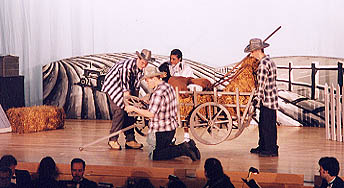
Cowen children acting out cocooning process.
We found that cowen members were quite informative and quite pleasant. They came from all levels of farming, from tiny 2 acre farms to giant hundred acre farms. Each stressed that the cows are the first priority while cocooning, and that the cows at no time are harmed in any way.

An old picture of a cowen farmer recovered from a local barn. We do not know what cowen this farmer belonged to.
|
Cowens meet in the fall on the full moon of September. Each member of the Cowen brings a bushel of hay to be blessed. Once their bushel had been blessed, they take it back home and bury it in the field where the cocoons would be left for the fall. It is believed that this hay would prevent the ground from freezing underneath the cocoons. The farmer then goes in the field and collects as much hay as needed for the cocoons. |
The cows are be brought together and the farmer explains what is about to happen to them. Cows are then taken one by one into the field and wrapped with hay.Once wrapped securely, the farmer sprinkles the finished cocoon with dirt.
This process has changed little from the beginning. The only changes are the machines used to collect the hay and create cocoons. Many of the cowens may not completely believe in the sprinkling of the dirt, but many follow it to keep the tradition going.
Cocoons have also evolved in design. Not only are there single cocoons, but community tunnels.
Farmers who are trained by the elders of the Cowen line up all of their cocoons and, cover them with plastic.
The cows can then chew out the sides that connect so they are able to socialize with the other cows.
As mentioned before, combo packs are also made. These smaller bundles usually contain a few smaller animals such as sheep, chickens, and rabbits. These combo packs are stored along with the cocoons, and the animals again eat their way out of the packs.
This practice evolved after the cow cocoons, but has been grouped with cocooning for obvious reasons. Combo packs are generally accepted in farming communities, which gives hope to the cowens in getting cocooning out into the public. |
 |
We have found evidence that clearly shows the involvement of the government in this issue. This picture shows without a doubt that a cover-up about the cocoons is indeed occurring.
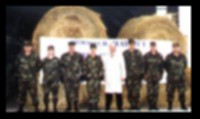
The government seeks to hide cocoons from the public, and has been rumored to have been responsible for various cocoon burnings. Why they government is doing this, we don't know. We haven't been able to find anyone to comment on this yet, but we're still looking.
In our search for information, we tried talking to the cows. Most were unwilling to speak with us due to the pressure from the herd. Most herds were under the impression that the time for revealing the cocoons to the world had not yet arrived. It was difficult to find a cow that would break this vow of silence. We did find a few that were willing to speak, and only one that would supply her name. Freda spoke with us briefly about the cocooning process. Here is what she had to share with us:
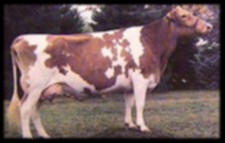
"I don't quite understand why cocooning is so taboo" -Freda
|
"Well, I have personally spent 3 winters in cocoons. Last year I was in a community tunnel for the winter. I would have to say that I have never experienced any difficulty or pain while in the cocoon.
In fact, I find it to be a relaxing time where I can sort out my thoughts and reflect on the season.
I know that when it comes time for my children to be put into cocoons this fall, I will not be worried in the least. I don't quite understand why cocooning is so taboo. Humans puzzle me greatly. Do you have any hay?" |
Not all cows are able to show their faces. We spoke with a few ladies and discovered that some cows want their secrets kept. Fear of humans seems to the main concern among the cows we spoke to.
Here are some of their comments:
"Of course we don't want everyone to know. It's bad enough that we can't even stand in fields without stupid kids pushing us over. That really hurts when they do that."
"I wouldn't feel safe knowing that some kid could just light my cocoon on fire." |
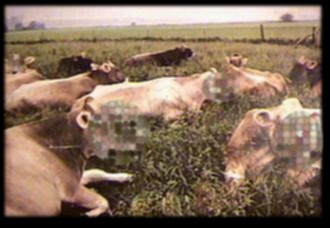
we have blurred the faces to protect the innocent
|
Many people are becoming aware of the cocooning practice and have so far shown support. We have spoken with a few people and gathered some of their comments.Each were asked what they thought of cow cocooning and the farmers who do it.
"I personally don't have any issues with it." -Mr. Wickshaw of Wickshaw Imports
"It makes more sense then spanking them with willow reeds." -Name Withheld
"The true nature of the cow cocoons is being kept from the public.
There is an obvious lack of coverage in the media on cow cocoons.
I think the public would be supportive if they did instead of treating it like a witch hunt."
- Schizoid of D-Trash Technologies
"What the hell are you talking about?" -Name Withheld
"I don't care about them." - H. Porter
"I am not authorized to comment on my opinions at this time." -I.R.Hudson
While many myths still haunt the cocooning practice, the outlook for them is good. Recently people have started to see these cocoons and community tunnels in farmers fields and have begun to ask questions.
Not wanting to be persecuted again, the story given today is that these are just hay bushels being stored for the winter.
While cocoons are a natural way to protect the cows from the ravages of winter, those who practice this still hide in fear. Slowly the farmers have begun to speak up, and they hope that cocooning will be accepted once again. We hope to continue brining you news on this subject, and encourage those who practice cocooning to break the silence.

This is a picture from the 50s showing farmers gathering hay for cocooning.
|











